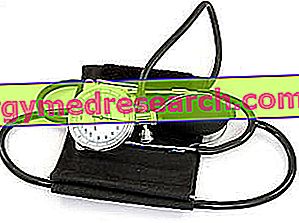Generality
The dosage of plasma or urinary metanephrines represents a simple and reliable test for the screening of pheochromocytoma.
Metanephrines derive from the metabolism of catecholamines, hormones produced and secreted by the adrenal medullary in order to prepare the body to deal with stressful events.

What are
- Metanephines and normetanephrine are metabolites of epinephrine (adrenaline) and norepinephrine (noradrenaline).
- Epinephrine and norepinephrine are catecholamines (hormones) that help regulate blood flow and pressure in the body, and that play an important role in stress response.
- Catecholamines are produced by the medullary (internal portion) of the adrenal glands and are secreted into the blood.
- Once these hormones have completed their action, they are metabolized to inactive compounds:
- Norepinephrine is converted to normetanephrine and vanilmandelic acid (VMA);
- Epinephrine is converted into metanephrine and VMA.

Metanephrine and pheochromocytoma
Pheochromocytoma is a generally benign tumor that affects the adrenal glands, causing catecholamine hypersecretion ; consequently, the plasma and urinary levels of adrenaline and noradrenaline increase, but also of the respective metabolites, called metanephrines .
When possible, the differential measurement of metanephrines (metanephrine and normetanephrine) is recommended, because sometimes the tumor secretes only one type of catecholamine (adrenaline or noradrenaline); therefore, especially in the case of poor secretion, the non-differentiated measurement could give a false negative result. Moreover, the possible relief of an increased secretion of metanephrine or adrenaline immediately directs the localization investigation towards the adrenal gland, the exclusive site of epinephrine synthesis (while norepinephrine can also be secreted by some nerve endings, therefore by extra-adrenal pheochromocytomas or paragangliomas).
Because they measure themselves
All patients suffering from poorly controlled hypertension, with persistent symptoms or sudden accesses testifying to adrenergic hypersecretion (headaches, headaches, anxiety, anxiety, palpitations and heartbeat more energetic cardiac).
The examination is carried out starting from a small blood sample taken from a vein of the forearm, as happens for most blood tests.
When is the exam prescribed?
The plasma metanephrine test measures the concentration of metanephrine and normetanephrine in the blood.
The examination is required mainly when there is the suspicion of a pheochromocytoma or a paraganglioma (rare extra-adrenal tumor). These neoplastic forms can produce a large amount of catecholamines, with a significant increase in the concentrations of metanephrines and normetanephrines.
The doctor can prescribe the metanephrine test when the patient is hypertensive and shows persistent or recurrent symptoms, such as:
- Headache;
- Palpitations;
- Sweating;
- Nausea;
- Anxiety;
- Tingling in the extremities.
Sometimes, the test is required in cases where the patient has been accidentally diagnosed with a tumor of the adrenal glands.
The plasma metanephrine test is very sensitive and the predictive value of the test is very good, ie if the blood concentrations are high, it is likely that the patient has pheochromocytoma.
Normal values
Normally, both catecholamines and their metabolites are present in small amounts in the blood and urine.
The reference values for plasma metanephrines are:
- Metanephrines: <90 pg / ml;
- Normetanephrine: <180 pg / ml.
Note : the reference interval of the exam can change according to age, sex and instrumentation used in the analysis laboratory. For this reason, it is preferable to consult the ranges listed directly on the report. It should also be remembered that the results of the analyzes must be assessed as a whole by the general practitioner who knows the patient's medical history.
Metanephrine Alte - Causes
The increase in plasma metanephrines may indicate the presence of a pheochromocytoma.
In most cases, pheochromocytomas can be surgically removed, eliminating the problem of hypertension, the symptoms and complications associated with it.
Other causes of high metanephrines
Slightly increased plasma metanephrine levels may be the consequence of chronic sympathetic activation, such as that which follows chronic severe pathologies (such as heart failure).
Also the abuse of nicotine, caffeine, alcohol and certain types of drugs (amphetamines, cocaine or ephedrine), as well as stress or anxiety in view of the exam, can increase the levels of catecholamines and metanephrines in the blood.
To resolve any doubts, a suppression test can be performed with clonidine (300 mg orally), a drug capable of inhibiting the release of catecholamines by the sympathetic system; consequently, the failure to decrease catecholamine and metanephrine levels confirms the tumor (pheochromocytoma or paraganglioma).
Before the metanephrine dose, the use of antidepressants and psychoactive substances should be suspended for two weeks as prescribed by the doctor.
Low Metanephrine - Causes
Low levels of metanephrines are not usually associated with medical problems and / or pathological consequences, therefore they are not considered clinically relevant.
How to measure them
For the examination of plasma metanephrines a blood sample should be taken from a vein in the arm. It may be necessary for the patient to lie down and remain calm for the previous 15-30 minutes and during sample collection. In other circumstances, it is sufficient to remain seated just before the withdrawal.
Preparation
Exam preparation is very important for the accuracy of the result. In particular, it is necessary to be fasting for 8-10 hours before taking blood samples, taking care to avoid above all:
- Foods containing caffeine (soda, chocolate);
- Tea and / or coffee (including decaf);
- Tobacco (cigarettes or cigars);
- Alcohol.
As for drugs, the suspension of:
- Epinephrine or epinephrine analogues in the week (at least) prior to the test;
- Acetaminophen in the 48 hours prior to collection.
In any case, it is always advisable to ask your doctor which medicines can interfere with the test result.
Interpretation of Results
- If blood concentrations of metanephrines and normetanephrine are normal, the patient is unlikely to have pheochromocytoma.
- If the metanephrine value is moderately high, the doctor can re-evaluate the therapies, the diet and the stress level to see if there are any interferers. Subsequently, the test can be repeated, perhaps together with the catecholamines on the 24-hour urine and / or urinary metanephrines, to check if the result is still high. In the latter case an ultrasound is prescribed, otherwise it is unlikely that the person is affected.
- If the concentration is high in a patient who has had a pheochromocytoma or a paraganglioma, it may be due to a relapse.



